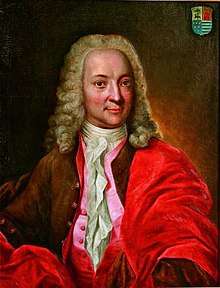Johan Lorentz Castenschiold
Johan Lorentz Carstens (13 May 1705 – 19 June 1745) was a Dutch-Danish landowner who was ennobled.[1]
Johan Lorentz Castenschiold | |
|---|---|
 | |
| Born | 13 May 1705 St. Thomas, Danish West Indies |
| Died | 19 June 1745 (aged 40) |
| Nationality | Danish |
| Occupation | Landowner |
Early life
Carstens was born in 1705 on St. Thomas in the Danish West Indies, the son of plantation owner Jørgen Carstens and Margrethe Volckers. His mother, a daughter of Johan Lorentz who was governor on the island, had brought considerable wealth with her into the marriage. His father had brought the Mosquito Bay Plantation (Moskito Bugten) into the marriage.
Property in the Danish West Indies
Johan Lorenz Carstens inherited his father's sugar plantation at Mosquito Bay on St. Thomas in 1720. He married Jacoba von Holten (1705–1751) in 1728. She was a daughter of former governor Joachim Melchior von Holten. She brought the plantations Pearl and Crown with her into the marriage. Carstens also acquired 400 tønder of land on St. Croix when Denmark purchased the island from France in 1733.
Personal life
The Carstens family moved to Copenhagen in 1739. They lived in a house in Store Kirkestræde. He played a central role in Danish trade with sugar and slaves. He purchased Knabstrup Manor in 1745 and was ennobled under the surname Castenschiold on 12 March that same year.[2]
Johan Lorentz Castenschiold and Jacoba von Holten were the parents of Carl Adolph Castenschiold (1740–1820) and Joachim Castenschiold (1743–1817). Johan Lorentz Castenschiold died from smallpox on 19 June 1747. His widow purchased Hørbygaard in 1748. She lived on the estate until her own death in 1751.[3]
References
- "Var det værre at være fæstebonde i Danmark end slave i Vestindien?". Krop & Sundhed (in Danish). Retrieved 25 August 2018.
- "Knabstrup". danskeherregaarde. Retrieved April 1, 2019.
- "Hørbygaard". danskeherregaarde. Retrieved April 1, 2019.